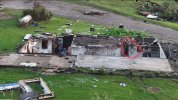Ozonelayer
Member
Assuming its empty, lets do the calculations.View attachment 46962
View attachment 46963
View attachment 46961View attachment 46960
Looks like it was one of these bad boys.
Using some quick geolocating, the hill is an approxamite 15 degree angle. Now for the math. (Using bold cause its easier to see)
Train car dimensions:
Length L = 60.1 ft ≈ 18.31 m
Width W = 10.8 ft ≈ 3.29 m
Height H = 10.5 ft ≈ 3.20 m
Mass m = 63,600 lbs ≈ 28,850 kg
Position: 40 m up a 15° slope
Car shape: approximate cylinder (frontal area roughly circular when facing wind)
Step 1: Estimate Frontal Area
A ≈ H × W = 3.20 × 3.29 ≈ 10.53 m²
Step 2: Estimate Wind Force
F_wind = 0.5 × ρ × C_d × A × v²
ρ = 1.225 kg/m³, C_d ≈ 1.2, A = 10.53 m²
F_wind ≈ 0.5 × 1.225 × 1.2 × 10.53 × v² ≈ 7.74 v² [N]
Step 3: Determine Resistive Force (Static Friction + Grade)
Rolling resistance: F_rr = μ_rr × m × g × cosθ
μ_rr ≈ 0.002, g = 9.81 m/s², θ = 15°
F_rr ≈ 0.002 × 28,850 × 9.81 × cos15° ≈ 546.7 N
Grade resistance: F_grade = m × g × sinθ
F_grade ≈ 28,850 × 9.81 × sin15° ≈ 73,300 N
Total resistive force: F_resist = F_rr + F_grade ≈ 546.7 + 73,300 ≈ 73,850 N
Step 4: Solve for Wind Speed
Set F_wind = F_resist to just start moving:
7.74 v² = 73,850
v² ≈ 73,850 / 7.74 ≈ 9,542
v ≈ 97.7 m/s ≈ 219 mph ≈ 352 km/h
So unless I am wrong (I could very well be. I'm still learning how to calculate windspeed), It would mean the Train Car had to have been exposed to ~220 MPH winds at minimum



